Paint the town red
When you're in a celebratory mood, do as the Japanese do. Dress up and dine on traditional fare at a fine Japanese restaurant where you can relax, admire the porcelain and savor every bite.
 Jushu
The essence of Kansai cuisine
Jushu
The essence of Kansai cuisine
 Koguma
Fine ingredients masterfully prepared
Koguma
Fine ingredients masterfully prepared
 Nihon Ryori TAKEMOTO
Seasoned skills on stage
Nihon Ryori TAKEMOTO
Seasoned skills on stage
 Ubuka
Shellfish and more shellfish
Ubuka
Shellfish and more shellfish
 Ichikawa
Sushi crafted with dedication
Ichikawa
Sushi crafted with dedication
Jushu寿修
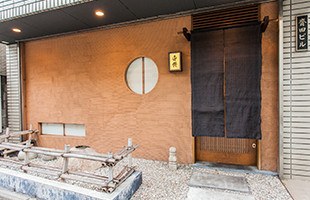
Phone: 03-6427-5167
- Address:
- 1F, Saida Building, 2-16-1 Nishi-Azabu, Minato-ku, Tokyo
- Open:
- Weekdays, Saturdays and the day before holidays
Dinner 18:00 – last order 23:00 - Closed:
- Sundays and holidays
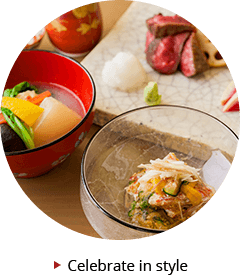
Celebrate in style
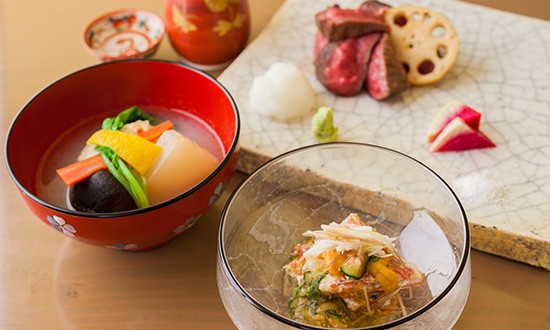
The single course comprises 9 dishes, starting with 2 appetizers followed by soup, sashimi, fried fare and other dishes. The cuisine is attractive but simply presented. "I never grace my dishes with inedible garnishes," Chef Senzaki says with pride. Each dish is skillfully served with careful attention to pace, order, flavor variance and ingredient variety to the amusement and satisfaction of guests.
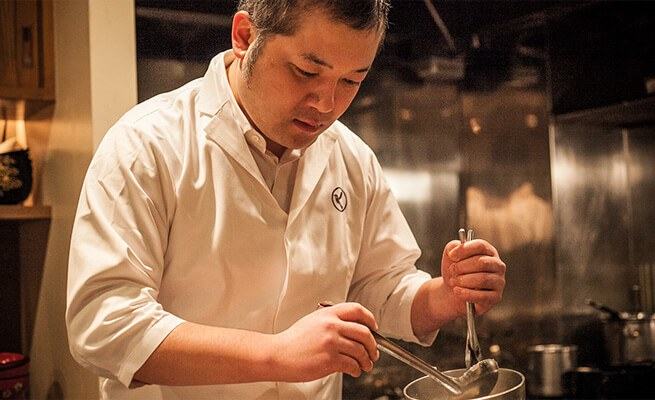
Owner-chef Senzaki's gently rich and flavorful Kansai-style kappo cuisine is prepared in mild dashi and features ingredients from Kansai and Kyushu, his place of birth.
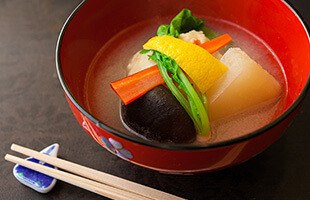
Minced crab, Shogoin daikon (Japanese radish) and mekabu (kelp) simmered to perfection in mild dashi sprinkled with ground turnip.
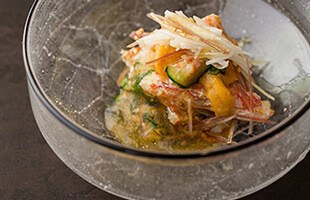
Today's appetizer is hairy crab and sea urchin dressed in Tosazu (seasoned vinegar) and served in select tableware.
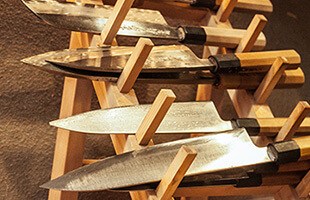
The souls of craftsmen dwell in their knives. Each blade is meticulously sharpened and polished with pride.
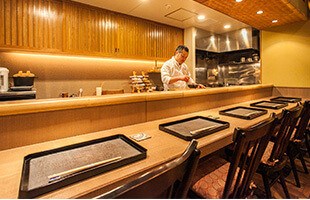
The counter provides a casual stage for observing the chef's artisanship in the intimate Kansai kappo style.
The essence of Kansai cuisine
Walk for about 5 minutes from the corner of Nezu Museum towards Nishiazabu and you'll likely stumble across Jushu Japanese Restaurant in a quiet little neighborhood. You may hesitate to enter when first encountering its exclusive entrance. But once you open the door, the casual atmosphere, welcoming counter and unpretentious owner-chef Masaaki Senzaki will put your mind at ease.
The menu consists of a single traditional Kaiseki course that begins with an appetizer, followed by various small dishes including soup, sashimi, fried fare and simmered cuisine. Chef Senzaki spontaneously adds off-menu dishes as you dine to surprise and delight.
Many ingredients, such as kue (kelp grouper) and Saga beef are from his native land, Kyushu, and others are from Kansai where he perfected his craft. This combination brings a depth to his cooking that Japanese connoisseurs appreciate. While the course flexibly varies, all dishes reflect the traditional flavors of Kansai cuisine with its mild dashi stock, in which chef Senzaki emphasizes the kelp flavor and occasionally adds vinegar good enough to drink.
The name Jushu, derived from the writings of Confucian philosopher Mencius, conveys the message that one must strive every day. Chef Senzaki takes the message to heart and never lets rising fame go to his head.

Phone: 03-6427-5167
- Address:
- 1F, Saida Building, 2-16-1 Nishi-Azabu, Minato-ku, Tokyo
- Open:
- Weekdays, Saturdays and the day before holidays
Dinner 18:00 – last order 23:00 - Closed:
- Sundays and holidays
Koguma小熊

Phone: 03-5537-7444
- Address:
- 3F, Sakaguchi Building, 5-5-13 Ginza, Chuo-ku, Tokyo
- Open:
- Lunch 12:00 – last order 13:00
Dinner 17:30 – last order 21:00 - Closed:
- Sundays, holidays and 1st, 3rd and 5th Saturdays of the month
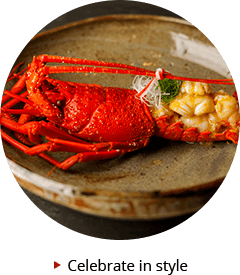
Celebrate in style
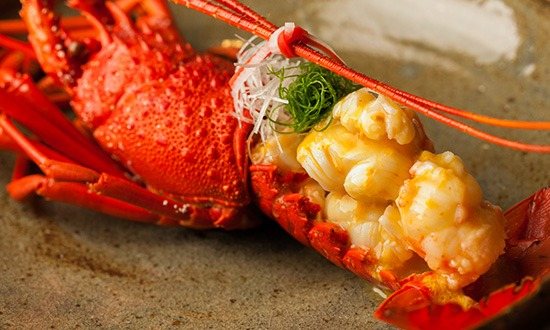
Gorgeous steamed lobster with celebratory red and white ribbons was served as a New Year's dish. Chef Koiwa enjoys preparing uncommon dishes and periodically includes soups containing suppon (soft-shell turtle). His dinner courses always incorporate one meat dish and at least one creative surprise.
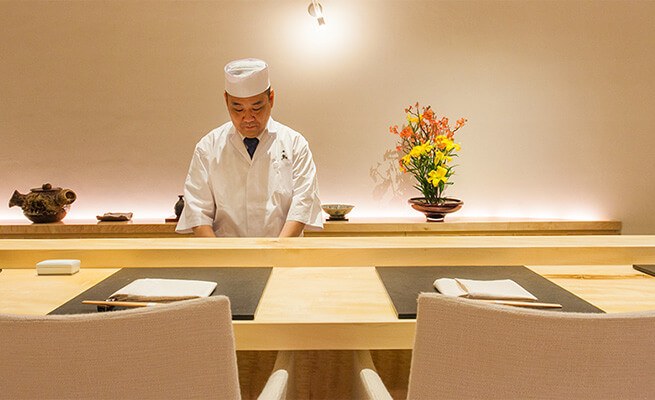
Owner-chef Hirotaka Koiwa brings out the best flavor of every ingredient using techniques learned at restaurants specializing in Kaiseki and Kyoto cuisine. "Rather than adding flavor," he says, "I make dashi soup stock delicious from the start."
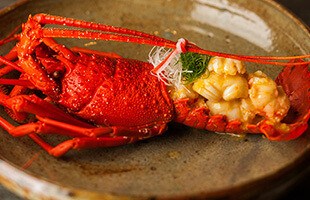
Crunchy steamed lobster is simmered in sake and topped with tasty prawn miso (viscera) sauce.
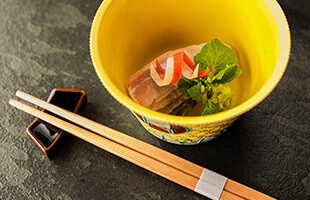
Layers of astonishingly flavorful, marbled sashimi Shirakawa (white tilefish) and kelp are served with herbs.
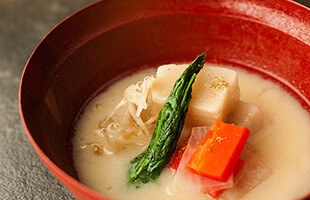
Koro (whale skin) rich in collagen, with a soft, melt-in-your-mouth consistency, is served in white miso soup.
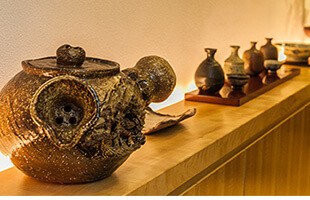
Bizen-yaki and Karatsu-yaki created by living national treasures join works by Cambodian artist Im Saem on display.
Fine ingredients masterfully prepared
Whether displaying valuable antiques and masterpieces crafted by living national treasures or serving seasonal ingredients rarely seen at other restaurants, owner-chef Hirotaka Koiwa tells us, "Ingredient quality and measured technique are everything. No compromise is acceptable."
Koguma opened in June 2014 and has already earned the respect of demanding gourmets. Chef Koiwa takes pride in his aging techniques, leaving each variety of fish in the refrigerator for just the right amount of time to bring out the best possible flavor. "Today," he announces, "I'm serving Shirakawa (white tilefish) that was aged for 19 days." The fish is so delicious, with its exquisitely refined sweetness, that customers are literally moaning with delight. He also ages other meats and, to everyone's surprise, rice. In the winter, he rinses the rice and leaves it out for about a week at low temperature to increase its sweetness.
Chef Koiwa questions everything in his efforts to bring out the full flavor of every ingredient and serve better tasting food. "I've prepared a dish appropriate for New Years," he declares with a smile. The tableware and decorations are delicately festive and every ingredient has a traditional meaning his Japanese customers understand. It's enough to make them proud of their extraordinary culture and cuisine.

Phone: 03-5537-7444
- Address:
- 3F, Sakaguchi Building, 5-5-13 Ginza, Chuo-ku, Tokyo
- Open:
- Lunch 12:00 – last order 13:00
Dinner 17:30 – last order 21:00 - Closed:
- Sundays, holidays and 1st, 3rd and 5th Saturdays of the month
Nihon Ryori TAKEMOTO日本料理TAKEMOTO
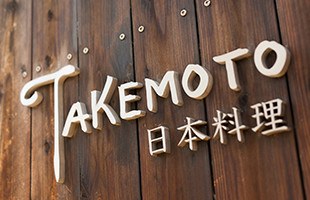
Phone: 03-3780-6272
- Address:
- 1-A, Daikanyama Twelve II, 8-10 Uguisudani-cho, Shibuya, Tokyo
- Open:
- Lunch 12:00-13:30 (only with a reservation by the day before)
Dinner 18:00 to arrival no later than 22:00 (only with a reservation by that day) - Closed:
- Irregular
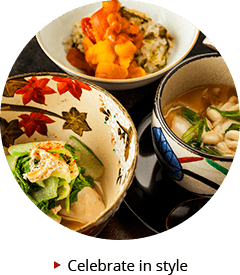
Celebrate in style
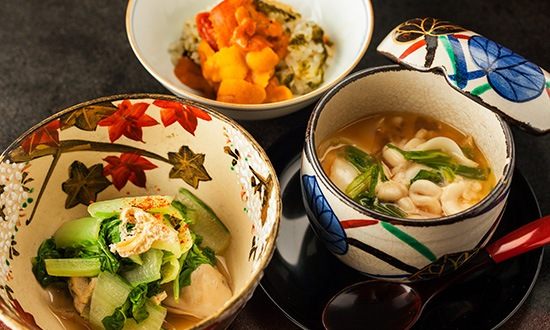
Most dishes are simply cooked to bring out the full taste of the excellent ingredients. All are prepared using the same superb dashi stock. The course changes daily, except for the saba (mackerel) sushi that is always served halfway through the meal and a rice dish that finishes the course.
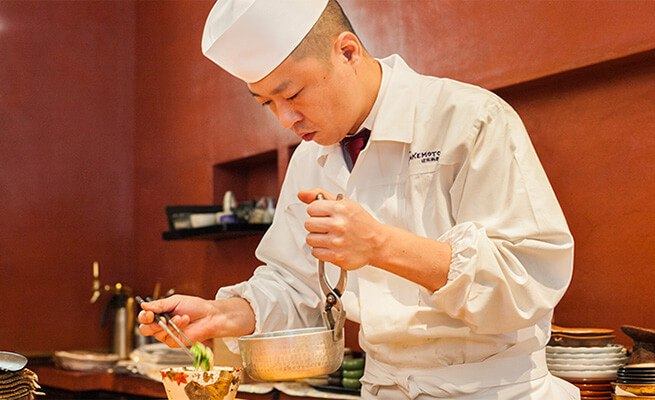
From the center of the counters, Chef Takemoto displays renowned skills he mastered at top restaurants. He moves efficiently, occasionally entertaining guests with casual talk.
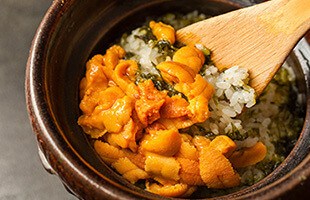
Depending on the season, the final rice dish features uni (sea urchin) as shown, oysters, bamboo shoots or Matsutake mushroom.
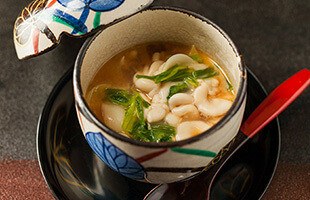
Steamed shirako (cod milt) and velvety lily bulb drenched in rich dashi stock taste like soft flavored custard.
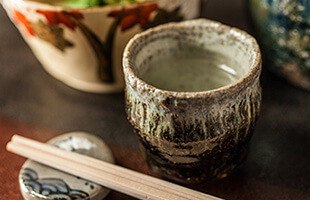
Takemoto's collection of sake utensils and tableware includes expressive earthy ceramics and lacquerware.
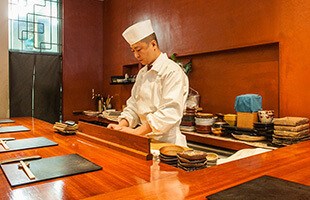
The centerpiece is a comfortable counter where Chef Takemoto stands closer to or further from guests depending on their wishes.
Seasoned skills on stage
After training for years at Kanetanaka, Japan's hallmark restaurant, and working as executive chef at ryotei restaurant Mizuno in Mukojima, owner-chef Kentaro Takemoto decided to launch his own restaurant with an open dining area where he can perform.
"When I'm near the guests, I want to please them even more," says Takemoto. He serves dishes to match the pace of his guests and expertly times every casual chat. Those sitting at the counter experience authentic Japanese cooking and service at its finest in a warm, friendly atmosphere.
The ambience is comfortable, but the food is prepared in an extremely traditional manner. Takemoto's dashi stock, fundamental to Japanese cuisine, is prepared with such artistry that connoisseurs instantly recognize his culinary genius. He uses the best bonito flakes and kelp as the base, adding tuna flakes, Soudagatsuo (frigate tuna) flakes, sake or other ingredients depending on the recipe. His subtle sense and knowhow truly bring out the best flavor of seasonal ingredients. When select produce in peak season is combined with his dashi, the results are profound.
Authentic Japanese cuisine prepared by a chef trained at first-class restaurants using the best quality ingredients… there is simply nothing better. At Takemoto, while casually relaxing at a counter seat, you can make this unforgettable experience your own.

Phone: 03-3780-6272
- Address:
- 1-A, Daikanyama Twelve II, 8-10 Uguisudani-cho, Shibuya, Tokyo
- Open:
- Lunch 12:00-13:30 (only with a reservation by the day before)
Dinner 18:00 to arrival no later than 22:00 (only with a reservation by that day) - Closed:
- Irregular
Ubukaうぶか
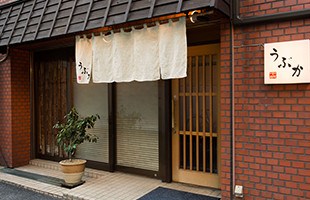
Phone: 03-3356-7270
- Address:
- 1F, IS 2 Building, 2-14 Araki-cho, Shinjuku-ku, Tokyo,
- Open:
- Weekdays, Saturdays and the day before holidays
Dinner 18:00 – last order 23:30 - Closed:
- Sundays and holidays
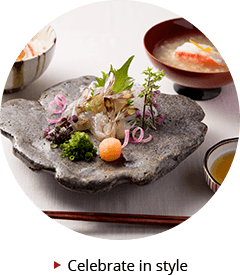
Celebrate in style
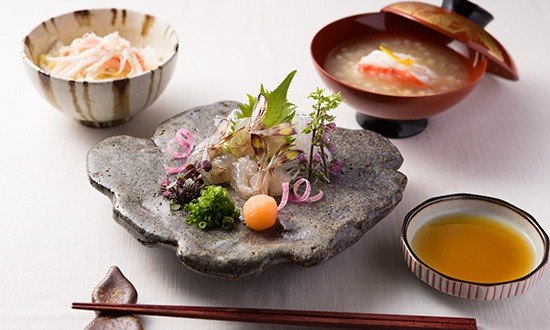
The omakase (chef's choice) course dinner consists of 8 dishes, excluding pickles and fruit. Kato uses varieties of shrimp and crab from all over Japan, preparing each differently to draw out their best taste. While heeding basic Japanese culinary philosophy, Kato also serves original items that are not entirely Japanese, such as Japanese style bisque.
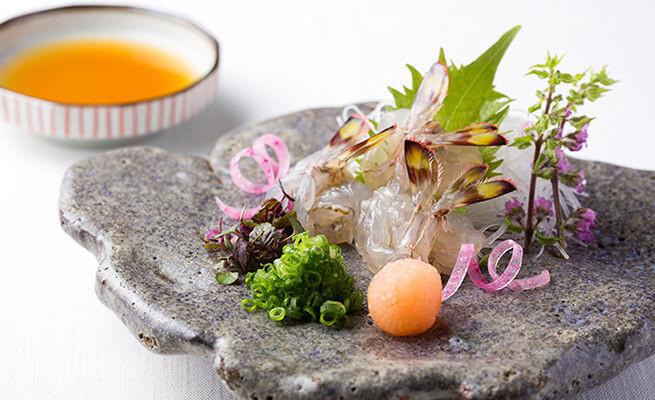
Prawn sashimi with ponzu (citrus vinegar) dip. The omakase (chef's choice) course always includes crab or shrimp sashimi. According to Kato, "no other prawns can compare with the flavor and texture of prawns from Chita Peninsula"
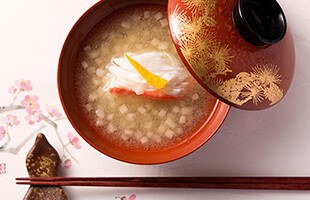
A generous serving of King crab in dashi broth with grated and cubed Shogoin daikon (Japanese radish).
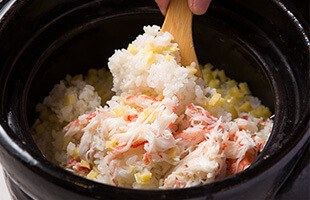
Rice with fresh snow crab and kuwai (water chestnuts). This dish may feature shrimp and other vegetables depending on the season.
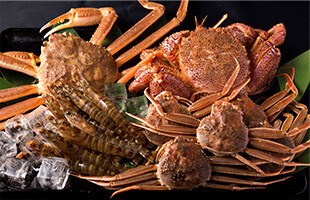
Shellfish arrives directly from local fishermen or is carefully selected each morning by Kato at Tsukiji Market.
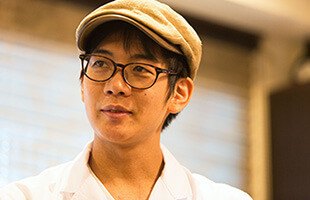
Kato cheerfully acknowledges, "My restaurant isn't for everyone." But it's one of the most popular restaurants in the Araki-cho area.
Shellfish and more shellfish
Ubuka specializes in shellfish and was launched by crustacean-loving Kunihiko Kato, who started his culinary career at famed crab chain restaurant Kanidoraku because he was under the impression that staff members could eat as much crab as they wanted. His signature deep-fried prawn recipe was inspired by "an idea that kept appearing in my dreams every night," he chuckles.
"Most restaurants serve deep-fried prawns after removing the best tasting miso (viscera), but I kept imagining how delicious they would be if the juicy viscera came flowing out from the spongy meat within the shell." He stopped dreaming and started testing recipes for over half a year, finally concocting his current recipe that wraps the prawns with prawn viscera and Sauce Americaine in spring-roll paper before frying. Kato's deep love for shellfish makes even this painstaking work a pleasure.
His classic Japanese culinary philosophy is that "everything depends on using quality ingredients and bringing out their best flavor". He procures fresh, high-quality ingredients every morning at the Tsukiji Market or has them delivered directly from contract fishermen. As for bringing out their best taste, he applies the culinary skills he mastered at a ryotei restaurant in Kyoto. Every shrimp and crab receives his loving attention.

Phone: 03-3356-7270
- Address:
- 1F, IS 2 Building, 2-14 Araki-cho, Shinjuku-ku, Tokyo,
- Open:
- Weekdays, Saturdays and the day before holidays
Dinner 18:00 – last order 23:30 - Closed:
- Sundays and holidays
Ichikawaいちかわ
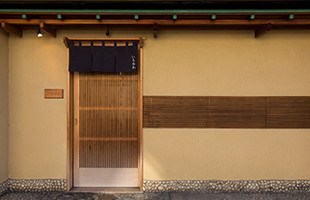
Phone: 03-3705-2266
- Address:
- 4-27 Nakamachi, Setagaya-ku, Tokyo
- Open:
- Mondays, Tuesdays, Thursdays, Fridays, Saturdays and day before holidays
Dinner 18:00 – last order 20:30
Sunday 12:00 – - Closed:
- Wednesdays and irregular days
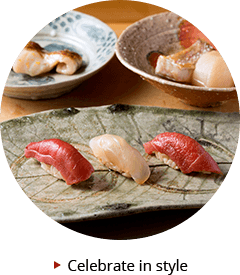
Celebrate in style

The omakase (chef's choice) course includes 12 assorted nigiri sushi and 4 to 5 dishes served in between. 5 or 6 of the sushi toppings are tuna — 2 otoro (fatty marbled tuna), 1 chutoro (medium fatty tuna), lean and zuke (marinated). Other dishes reflect Chef Ichikawa's culinary skills acquired through 7 years of training at Japanese ryotei restaurants. The dishes go especially well with the Junmai sake and non-filtered namazake (raw sake) that Ichikawa recommends.
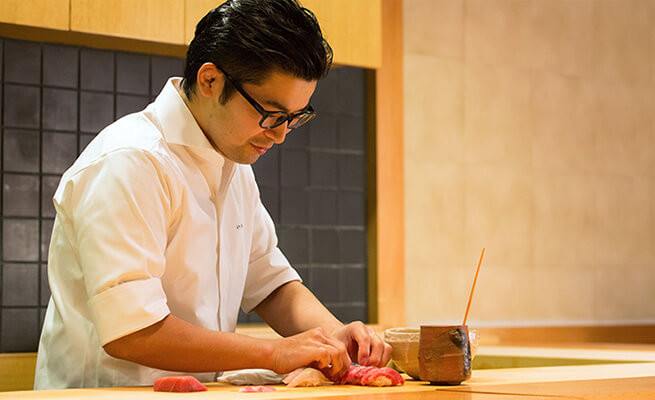
Owner-chef Ichikawa speaks little because he believes in devoting himself fully to his work. He finds the best quality ingredients at Tsukiji Market every morning at 5am and employs skills mastered at established ryotei restaurants in Kyoto.
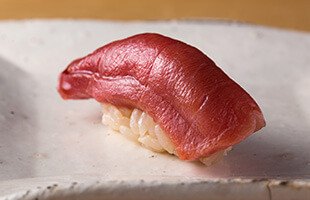
Chutoro (medium fatty tuna) from Minmaya Port. The omakase (chef's choice) includes 5 to 6 different types of tuna sushi.
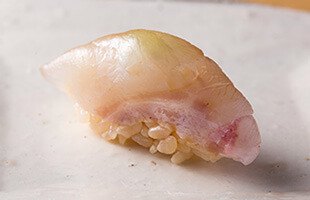
Kue (kelp grouper) from the Goto Islands with soy sauce and sushi rice seasoned with red vinegar spread joy through your mouth.
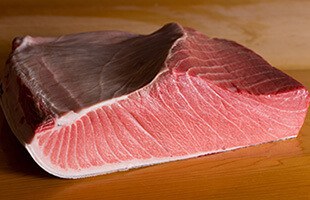
Nearly half the sushi toppings in the omakase (chef's choice) course are made from tuna procured from the same trusted Tsukiji market trader.
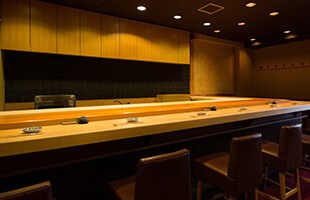
Ichikawa wants guests to leisurely enjoy their sushi and only accepts reservations per day that match the number of seats.
Sushi crafted with dedication
About 10 minutes by foot from Kaminoge Station, Ichikawa is located in a residential district on a street called Yoga Nakamachidori that may ring a bell for sushi connoisseurs. Indeed, Ichikawa is located in the very same premises as a very famous sushi bar that closed down.
"When planning to open my own shop, I found this site and my master warned me not to choose it because I was too shy with guests," said owner-chef Katsumi Ichikawa. But he took this as a challenge. Even though the shop is far from any train station and has no website, Ichikawa recalls, "I thought if I can succeed here through genuine good taste, I can survive anywhere."
Less than a year after its launch in 2012, Ichikawa became popular with gourmands and received a coveted star. His sushi is prepared in the traditional Edomae style and his other dishes in the omakase (chef's choice) course are prepared using techniques mastered at ryotei restaurants. Both exhibit his well-trained culinary expertise and are delivered to guests with perfect timing. There is little more you could ask for from a talented star-winning chef.

Phone: 03-3705-2266
- Address:
- 4-27 Nakamachi, Setagaya-ku, Tokyo
- Open:
- Mondays, Tuesdays, Thursdays, Fridays, Saturdays and day before holidays
Dinner 18:00 – last order 20:30
Sunday 12:00 – - Closed:
- Wednesdays and irregular days
*Articles are written based on information available at the time of publication.
More restaurants


